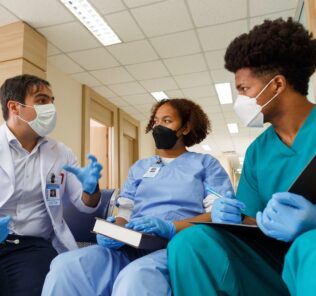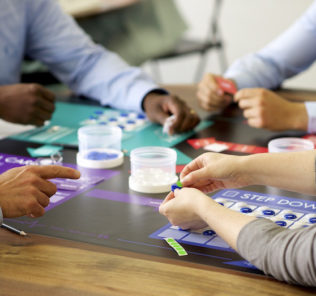How To Establish Effective Familiarization Across Healthcare Simulation
One of the most fundamental roles of a healthcare simulation technology specialist is enabling the learning objectives of their clients. Sometimes the best way to accomplish this is not to include, purchase, or moulage more for the learner, but rather to discern when elimination or simplification is needed to best enable learning objectives. One way to enable the healthcare simulation team to support focusing on learning objectives is effective familiarization. This HealthySimulation.com article explores how to effectively perform familiarization with a healthcare simulation space.
Familiarization with a learning space for all learner populations is a step that should happen before any clinical simulation event. The steps necessary to get to this outcome may vary depending on the learner’s experience in healthcare simulation, or where they are in their career or educational journey. However, not including familiarization in some form runs the risk of reactively interrupting valuable experiential learning when a topic could have instead been proactively explained or demonstrated.
What effective familiarization looks like, the order familiarization occurs, and even how familiarization is performed must change from one healthcare simulation team to the next. Medical simulation educators must also factor in the learner population, the simulation center’s resources, and even the cultural dynamics at play in the simulation environment. The ways in which this is made possible, as discussed in this article, are not designed to be exhaustive or chronological, but rather a living document that should be used to dialogue and expound upon to meet the needs of the learner.
Sponsored Content:
Set the Tone
First impressions matter. In psychology, this is often referred to as the “Halo Effect.” How one presents themselves initially can quickly build or lose rapport with someone they are meeting for the first time. The healthcare simulation team can capitalize on this opportunity by providing brief introductions at the start of their familiarization. This is a chance to let the learner know that their learning experience is being facilitated by a competent and confident professional. Introductions also serve as an organic way to segue into the prebriefing and “fiction contract.”
Related Healthcare Simulation Article: INACSL Standards of Best Practice: Prebriefing | Preparation & Briefing
Further, the social aspects of introductions and prebriefings communicate to the learner that they are in an environment that encourages contribution. This leads to the learner being more likely to actively participate in the familiarization and ask questions.
Sponsored Content:
Utilize Functional Methodologies
Identifying methodologies to be utilized offers an opportunity to mitigate the interruption of learning during an event. For example, one practice is to encourage the learners to think out loud and narrate their actions. This prevents faculty in a control room from having to ask what medication and dosage were pushed so the healthcare simulation technology specialist can trigger the appropriate physiological response, progressing the case.
This is also the time when the use of a “voice of god” (VOG) or “voice above” can be introduced. One way to do this is to let the learners know that if there is a sign/symptom that a manikin cannot depict (such as skin color/condition/temperature) that the information will be relayed to them. However, using the VOG with discernment as this resource could become more of a hindrance than a help in encouraging critical thinking on the part of the learner.
Identity the Space and Equipment Therein
Lack of space and familiarity with the equipment located within that space is a frequent and serious barrier to enabling learning objectives. One example can be found in a medical simulation where a learning objective is to recognize the need for advanced airway placement in a pediatric patient. The learning objective is not to find where a Mac 3 blade and a 5.5mm ETT are in a room that has never been in before while attempting to save a child’s life.
That may be an appropriate objective in another healthcare simulation event. Yet, in this medical simulation scenario, the task is a distraction and a barrier to the intended learning goal. These types of distractions are easily managed by familiarization with space, or by introducing a confederate/faculty member who will assume the role of a teammate that knows where resources are in the space.
Take Advantage of Cognitive Aids
Introducing the learners to the availability of cognitive aids empowers them to critically think and stay within the simulated environment without having to stop and ask for the VOG or faculty to intervene or provide answers. This is an opportunity to inform the learner population about the capabilities of the space, rather than what will specifically occur. The healthcare simulation team can most effectively accomplish this by communicating with the learner that informing them of the full capability of the space is not implying the need for all, or any, of those resources in the event to come.
The learners will be empowered to fully immerse themselves in healthcare simulation when they are aware that space has the capability of providing lab results, x-ray imaging, case media, or an in-room phone for consults. Moreover, they may not be aware that their Laerdal Simman 3G Plus allows them to perform a humeral IO or deltoid IM. Being unaware of the full capabilities of resources such as these is of great detriment to the realism of healthcare simulation and results in learners missing out on experiential learning. Therefore, learners should instead utilize the cognitive aids available to them. They can only do this if they know what those aids are.
Promote Safety
Overall, safety is paramount to the success and well-being of the learners and members of the healthcare simulation team. Safety is last on this list because this factor should be top-of-mind to the learner. Topics covered should include environmental precautions, personal protective equipment (PPE), and considerations around hazards like sharps or electricity.
Another best practice is to provide the learners with a cue, such as “this is not a simulation,” should any real-world injuries or concerns arise that require immediate attention. Performing thorough and efficient familiarization with a healthcare simulation space will not only enable learning objectives but allow the learners to fully engage in learning how to safely save lives.
Learn More About Actionable Steps to Increase Learner Participation in Healthcare Simulation
Dr. Rémy Roe is a retired U.S. Army special operations combat medic who currently works as a Simulation Technology Specialist at the Stanford University School of Medicine, Center for Immersive and Simulation-Based Learning (CISL). He has worked as a Healthcare Simulation Operator, Educator, and Developer around the globe, and served as the Senior Instructor at the largest Medical Simulation Training Center (MSTC) in the Department of Defense (DOD) before moving to Stanford. Dr. Roe earned his Ph.D. in Developmental Psychology and has master’s degrees in Personality Psychology and Sociology. A lifelong learner, Dr. Roe is currently pursuing his MBA.
Sponsored Content:






















